|
My 24 Hours Under the Sea by Ed Fisher - Photos by Jerry Greenberg
The closer I came to the breaking point, the less I could co-ordinate. I looked like a dehydrated prune and I felt as if my body were caught in a gigantic press.
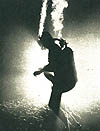 A dead man floats in seawater with his head level, arms extended out in front and legs dangling down below him. I know because I spent considerable time in this position in a condition that seemed at the time very close to death. I was sitting in the center of an inner tube which was secured 30 feet under the surface at French Reef - at the time, a thriving undersea community with a depth ranging from 30 to 60 feet three miles off Key Largo in the Florida Keys- a site I knew well. It was night, and all around me was pitch blackness save for the faint green light given off by my underwater lantern. As I looked out over the inky silhouette of the coral jungle, watching the sparkling of the tiny luminescent creatures that swarmed through the water by the millions, a massive gray ghost glided toward me. This was the shark I was waiting for and I wondered if he would attack, hidden by the night, or if my theory would hold up so that I could live to tell the others?
A dead man floats in seawater with his head level, arms extended out in front and legs dangling down below him. I know because I spent considerable time in this position in a condition that seemed at the time very close to death. I was sitting in the center of an inner tube which was secured 30 feet under the surface at French Reef - at the time, a thriving undersea community with a depth ranging from 30 to 60 feet three miles off Key Largo in the Florida Keys- a site I knew well. It was night, and all around me was pitch blackness save for the faint green light given off by my underwater lantern. As I looked out over the inky silhouette of the coral jungle, watching the sparkling of the tiny luminescent creatures that swarmed through the water by the millions, a massive gray ghost glided toward me. This was the shark I was waiting for and I wondered if he would attack, hidden by the night, or if my theory would hold up so that I could live to tell the others?
I had many reasons for wanting to make this dive. Back in 1952 I had tired of the underwater hunt. I had been spear fishing for four years in both California and Florida waters,and had tackled everything that a guy can get close enough to shoot at, including huge rays, eels, barracuda and ocean shark, and now I wanted something new. The underwater lungs and the powerful gas gun had equalized man against the dangerous creatures in the sea for short dives. The next challenge was to see what man could do against the element itself. Could he stand up against the pressure of the depths, against the cold and the dehydrating action of the salt water: Could he function sufficiently well in the black of night to survive in a jungle where every beast is blessed with sight and scent and sense of vibration 1,000 times more sensitive than his own?
I wanted to prove that he could, and so I made my plans. I would try to camp underwater on the ocean reefs far offshore for a period of 24 hours. I would carry on my back all the necessities for survival during that period, except for my reserve air supply, which were large cylinders lowered from a boat after I had set up my underwater camp site. The boat would then anchor some distance away so that I could in fact be alone day and night over the 24-hour period.
In 1954, I was to have my chance to try the experiment. Paul Arnold, and ardent adventurer himself, and president of Diving Corporation of America operated a scuba diving store in Miami where I'd been employed for a couple of years, and had just perfected a new diving regulator called the DiveAir. One day last August he asked me if I could think of a project to test and promote the new unit. Could I! This was a natural for what I had planned, and in two hours we had the ball rolling toward the organization of the world record 24-hour undersea marathon.
At last, August 21, 1954 the day we planned to make the dive rolled around. The weather was perfect, with bright sun and a flat calm surface on the Gulf Stream. three miles offshore from Key Largo, on French Reef, I dropped over the side, trolled behind the boat, and selected a spot where I wanted to set up camp. We anchored some distance downstream and back in the boat I got my gear ready.
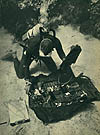 I had every piece of equipment I could conceivably need during my dive - a CO2 gas gun and sections of steel curtain-rod for darts to deal with sharks along with a rubber-powered Arbalete for hunting food fish, a deflated inner tube for creating my underwater bed, plenty of line, an underwater flashlight, waterproof notebook and grease-pencil for keeping a log, and survival food- candy and figs in waterproof containers. Leather gloves, wool socks, underwater signal gun and balloons, pliers, wire, a flag and collapsible staff for our Undersea Research Group, a collecting net, needle and thread for repairs, hammer and chisel, a hot-water bottle and syringe for drinking water, and a rat-trap to try to catch craw fish or fish the easy way. I wore a lightweight foam neoprene suit (only 1/4 thick) that covered me except for my hands, feet and face. This was the wet type, that is, water would seep under the suit, but it would still tend to reduce body heat escaping. Around one wrist I wore a waterproof Rolex and on the other a combination compass and depth gauge. The Divair unit consisting of a tank of compressed air, regulator and breathing manifold, a face mask and swim fins, completed my outfit.
I had every piece of equipment I could conceivably need during my dive - a CO2 gas gun and sections of steel curtain-rod for darts to deal with sharks along with a rubber-powered Arbalete for hunting food fish, a deflated inner tube for creating my underwater bed, plenty of line, an underwater flashlight, waterproof notebook and grease-pencil for keeping a log, and survival food- candy and figs in waterproof containers. Leather gloves, wool socks, underwater signal gun and balloons, pliers, wire, a flag and collapsible staff for our Undersea Research Group, a collecting net, needle and thread for repairs, hammer and chisel, a hot-water bottle and syringe for drinking water, and a rat-trap to try to catch craw fish or fish the easy way. I wore a lightweight foam neoprene suit (only 1/4 thick) that covered me except for my hands, feet and face. This was the wet type, that is, water would seep under the suit, but it would still tend to reduce body heat escaping. Around one wrist I wore a waterproof Rolex and on the other a combination compass and depth gauge. The Divair unit consisting of a tank of compressed air, regulator and breathing manifold, a face mask and swim fins, completed my outfit.
 At 3:08 I dropped off the ladder of the boat and struck out to my underwater campsite. As soon as I was underwater I felt the thrill of a new adventure, a new challenge, like when you first start diving, or discover a new reef, try a deep dive, or hunt your first shark. The spot I had chosen was a good one. Clean white sand led into a slight indentation on the side of the reef and here I would be able to keep my back to the wall should trouble come up in the form of an aggressive shark. I opened my knapsack and secured it to the the side of the reef, tying it to branches of elk horn coral.
At 3:08 I dropped off the ladder of the boat and struck out to my underwater campsite. As soon as I was underwater I felt the thrill of a new adventure, a new challenge, like when you first start diving, or discover a new reef, try a deep dive, or hunt your first shark. The spot I had chosen was a good one. Clean white sand led into a slight indentation on the side of the reef and here I would be able to keep my back to the wall should trouble come up in the form of an aggressive shark. I opened my knapsack and secured it to the the side of the reef, tying it to branches of elk horn coral.
Next job was to set up my underwater bed. First I tied three lies around the deflated inner tube - then tied each to strong sections of coral so that when I inflated the tube with my gas gun, the lines held the tube level and formed a perfect easy chair for underwater naps. Then I unfurled my Undersea Research Group flag and tied it to the collapsible staff which I mounted on the highest peak of coral in the camp site. Using the underwater compass, I drew a rough map of the location so that in the event I strayed out of sight of the camp (visibility was excellent so I could see over 100 feet) I could check my map which I put in a case on my belt.
I was able to make a few notations in my log book. With a grease pencil on pages made from artist's canvas, I wrote: "6:15 - First notation in log - just saw huge barracuda - have set up camp - depth according to gauge 45 feet, but I know that's off - estimate about 30 feet-"
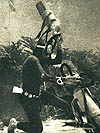 The tank I had on my back would last about an hour and 15 minutes at this depth, and when the time came around to change, I would know it, because the air would get stiff to breathe. I'd set the safety reserve button if I strayed far from camp, (an innovation on the Divair regulator) but normally I didn't activate it to avoid making any mistake during the many times I'd have to change air supply. The longer you stay underwater the harder it gets to think straight - has something to do with the absorption of nitrogen in the fatty tissue of the brain, just like in deep diving where you get narcosis below a couple of hundred feet. There it happens almost instantly at the depth an individual is susceptible, but even in this shallow dive it may become dangerous over a long period of time...how long no one knows.
The tank I had on my back would last about an hour and 15 minutes at this depth, and when the time came around to change, I would know it, because the air would get stiff to breathe. I'd set the safety reserve button if I strayed far from camp, (an innovation on the Divair regulator) but normally I didn't activate it to avoid making any mistake during the many times I'd have to change air supply. The longer you stay underwater the harder it gets to think straight - has something to do with the absorption of nitrogen in the fatty tissue of the brain, just like in deep diving where you get narcosis below a couple of hundred feet. There it happens almost instantly at the depth an individual is susceptible, but even in this shallow dive it may become dangerous over a long period of time...how long no one knows.
When I changed tanks, I'd take a deep, hard breath, from the air remaining in my used cylinder, unstrap the harness and swing the unit over my head. Then I'd remove the mouthpiece and put the used tank aside and pick up the mouthpiece of the new regulator attached to a full tank. After I put the new unit on, I'd clear the lines in the conventional manner by draining and blowing the water out of the exhale line.
It started to get dark early so I set up my improvised underwater camp light - a battery-powered lantern secured in a glass jug that floated upside down tethered to an anchor. 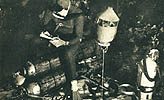 I had already pioneered night diving in the reefs of the Florida Keys and had made observations about reef creatures that at the time had never been described. The first issue was whether sharks would be more aggressive than during daylight and so far I had not found them any more or less dangerous at night at least to a scuba diver who is not engaged in spearing fish or splashing around on the surface. I found fish that were active during daylight generally hid in nooks and crannies of the reef and appeared to be in various states of comatose that allowed you to cautiously poke them before they reacted. Most striking were the parrot fishes which I discovered lurked in semi-comatose states in coral caves and exuded a transparent phlem-like substance that completely enveloped themselves. Later this would be alluded to as their "night-gown". Small wrasses would "sleep" lying flat on the sand and exude a phlegm-bubble that formed a transparent half-dome shield. If a predator disturbed the bubble, the wrasse was gone in an instant. I saw basket starfish which during the day were seen all scrunched up into an immobile knot but at night they would rise to the tops of coral branches and unravel their many-branched arms to create a two-dimensional mozaic net several feet in diameter to snare plankton. I had already pioneered night diving in the reefs of the Florida Keys and had made observations about reef creatures that at the time had never been described. The first issue was whether sharks would be more aggressive than during daylight and so far I had not found them any more or less dangerous at night at least to a scuba diver who is not engaged in spearing fish or splashing around on the surface. I found fish that were active during daylight generally hid in nooks and crannies of the reef and appeared to be in various states of comatose that allowed you to cautiously poke them before they reacted. Most striking were the parrot fishes which I discovered lurked in semi-comatose states in coral caves and exuded a transparent phlem-like substance that completely enveloped themselves. Later this would be alluded to as their "night-gown". Small wrasses would "sleep" lying flat on the sand and exude a phlegm-bubble that formed a transparent half-dome shield. If a predator disturbed the bubble, the wrasse was gone in an instant. I saw basket starfish which during the day were seen all scrunched up into an immobile knot but at night they would rise to the tops of coral branches and unravel their many-branched arms to create a two-dimensional mozaic net several feet in diameter to snare plankton.
After the reef was enveloped in utter darkness for the next couple of hours I explored the nearby reef both with my flashlight on and off. Fish like the Red Cardinal that normally stay hidden during the day were out schooling in the water column feeding on plankton and moray eels which normally are hunkered down with just their heads projecting out of the reef now were freely slithering amongst the crannies of the reef searching for sleeping prey. Around 10 pm I finally retreated back to camp to settle down and make some more entrees in my log.
First it appeared as a moving green haze appearing out of the inky blackness of the water column...then burst into full view within 20 feet from my position with my back to the reef wall....then, with a sinuous grace, the shark flipped back into the darkness. That was my only incidence with sharks during my dive...which was behavior consistent with my past experiences night diving on the Florida reefs.
Around midnight I was feeling somewhat tired and decided to retire to my inner tube chair and slipped into position and was pleased to find it secured me so in case I slept, I wouldn't drift off and find myself joined with the plankton drifting out somewhere in the Gulf Stream in utter darkness. Actually all through the rest of the night I had a fitful rest as I still had a vestigial worry that I might get plucked out of my slumber by a rogue shark.
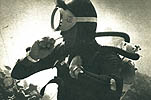 By the time daylight arrived around 7 in the morning, I was already feeling debilitated from the effects of hypothermia- a factor I was woefully ignorant of and unprepared for but busied myself with preplanned projects. The first was finding breakfast so I took up the Arbalet spear gun and within a few minutes had speared a small snapper. Returning to camp I cut out some fillets and had no trouble gulping them down and washing them down with sips of water from the syringe attached to my rubber water-bottle. The candy bars and figs were a welcome dessert as I never developed a fondness for sushi. Then (I am now ashamed to admit) I decided to carve my name and date on a brain coral to memorialize my venture and got to work with my hammer and chisel. (At that time my environmental consciousness had not been raised to realize what an irresponsible act this was and had the typical mindset of those who carved graffiti on archaeological and ecological sites the world over. I also realize my tying lines on elk horn coral and bumping into stag horn and other reef corals that such casual contact by recreational divers can cause collective damage that over time can destroy a fragile reef ecosystem. Eventually sports divers can be as destructive of coral reefs as the commercial diving for coral has been in the Philippines and other regions of the South Pacific where entire reefs have been devastated.)
By the time daylight arrived around 7 in the morning, I was already feeling debilitated from the effects of hypothermia- a factor I was woefully ignorant of and unprepared for but busied myself with preplanned projects. The first was finding breakfast so I took up the Arbalet spear gun and within a few minutes had speared a small snapper. Returning to camp I cut out some fillets and had no trouble gulping them down and washing them down with sips of water from the syringe attached to my rubber water-bottle. The candy bars and figs were a welcome dessert as I never developed a fondness for sushi. Then (I am now ashamed to admit) I decided to carve my name and date on a brain coral to memorialize my venture and got to work with my hammer and chisel. (At that time my environmental consciousness had not been raised to realize what an irresponsible act this was and had the typical mindset of those who carved graffiti on archaeological and ecological sites the world over. I also realize my tying lines on elk horn coral and bumping into stag horn and other reef corals that such casual contact by recreational divers can cause collective damage that over time can destroy a fragile reef ecosystem. Eventually sports divers can be as destructive of coral reefs as the commercial diving for coral has been in the Philippines and other regions of the South Pacific where entire reefs have been devastated.)
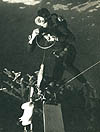 For the first couple of early morning hours I managed to putter about my camp but by 9 am the cold had become agonizing and my head and body felt like I was being squeezed in a cold, liquid vice. Although the summer temperature of the water over the Florida reefs averaged around 80 degrees...what I didn't know at the time was that this was still cold enough to cause hypothermia over a long enough exposure that caused my body temperature to drop. Nor had I anticipated that my 1/4 inch thick foam wetsuit would slowly compress to paper thinness providing no protection from loss of my body heat. It had probably totally compressed somewhere during the night and now I faced some 6 hours immersed in water that was some 18 degrees below my body temperature. In my ignorance of the factor of hypothermia I was becoming overcome by it's effect and had to deal with the agonizing cold, the growing difficulty in thinking clearly and disorientation. I felt like I was dying and sent a message to Paul and the Life magazine journalist and newsmen on the tender boat - via a note handed to a standby diver - "won't last more than 1 hour". A return note- composed by Paul Arnold read: "There is no substitute for Victory" (Paul is steeped in old-school European rhetoric) but this did inspire me to focus entirely on bearing up to the cold and debilitation that tormented me. I was able to stick it out for another six hours until sometime after 2:30 pm I began my ascent to the anchored buoy-line to do a half-hour decompression. (Although the manual says no decompression is necessary if a diver stays no deeper than 30 feet - no data was available pertaining to dive-times extending over a few hours (it would be years before saturation diving evolved). So just to be cautious about avoiding the bends, I had planned a half-hour decompression at a depth of ten feet.)
For the first couple of early morning hours I managed to putter about my camp but by 9 am the cold had become agonizing and my head and body felt like I was being squeezed in a cold, liquid vice. Although the summer temperature of the water over the Florida reefs averaged around 80 degrees...what I didn't know at the time was that this was still cold enough to cause hypothermia over a long enough exposure that caused my body temperature to drop. Nor had I anticipated that my 1/4 inch thick foam wetsuit would slowly compress to paper thinness providing no protection from loss of my body heat. It had probably totally compressed somewhere during the night and now I faced some 6 hours immersed in water that was some 18 degrees below my body temperature. In my ignorance of the factor of hypothermia I was becoming overcome by it's effect and had to deal with the agonizing cold, the growing difficulty in thinking clearly and disorientation. I felt like I was dying and sent a message to Paul and the Life magazine journalist and newsmen on the tender boat - via a note handed to a standby diver - "won't last more than 1 hour". A return note- composed by Paul Arnold read: "There is no substitute for Victory" (Paul is steeped in old-school European rhetoric) but this did inspire me to focus entirely on bearing up to the cold and debilitation that tormented me. I was able to stick it out for another six hours until sometime after 2:30 pm I began my ascent to the anchored buoy-line to do a half-hour decompression. (Although the manual says no decompression is necessary if a diver stays no deeper than 30 feet - no data was available pertaining to dive-times extending over a few hours (it would be years before saturation diving evolved). So just to be cautious about avoiding the bends, I had planned a half-hour decompression at a depth of ten feet.)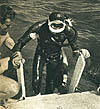
Just after 3:10 pm, 24 hours since entering the ocean I surfaced and swam to the transom of the recovery boat. After a rather painful extraction from my dive gear I was helped up the boarding ladder and seated down where my wetsuit was peeled off- and discovered to have been compressed to paper thinness. 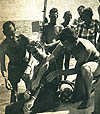 The skin on my hands was shriveled by the dehydrating effects of the salt water and my skin all over my body was painful to the touch. But the warmth of the sun on my body felt wonderful and quickly recuperated my body temperature and allowed me to fall into a deep sleep on a bench of the boat as it headed back to the docks at Key Largo. The skin on my hands was shriveled by the dehydrating effects of the salt water and my skin all over my body was painful to the touch. But the warmth of the sun on my body felt wonderful and quickly recuperated my body temperature and allowed me to fall into a deep sleep on a bench of the boat as it headed back to the docks at Key Largo.
Brief Aftermath: The 24-hour dive was my 15 minutes of fame as it was a featured story in Life Magazine with pictures by Peter Stackpole and front page news in newspapers around the world for one day. I did a couple of TV interviews but the event was mostly treated as a stunt rather than the precursor to what I had wanted to promote- that habitats could be built that would allow man to live and work for sustained periods underwater. I did get some employment by Healthways Sports Products to do some promotional shows - the largest in a national sports convention in Chicago where I performed underwater acts in a big aquarium. For the next few years there were spats of theater reported as beating my 24 hour underwater world record- all accomplished by a diver in either dry-suits or indoors in wet-suits in heated freshwater aquarium which of course eliminated all of the challenges of an undersea dive. It wasn't until years later that serious projects were developed to implement a variety of submarine habitats.
The most positive result of my notoriety was that it was probably a factor in my getting a job at the University of Miami Marine Laboratory as an underwater photographer working on a Navy research project which evolved over the next 15 years.
Deep Science National Geographic Magazine, September 2003 - story by Gregory Stone. Aquarius (at the time) the world's only ocean-floor habitat was installed 65 feet deep on Conch Reef 3 miles off the coast of Key Largo, Florida. 40 years ago it was popularly believed that humans would work and live underwater. Robert Sténuit became the first aquanaut to stay underwater in a pressurized environment for 24 hours, on September 7, 1962, after living at a depth of 200 feet in the Mediterranean Sea during a research project funded in part by the National Geographic Society. In 1963 U.S. Navy Capt. George Bond, using pressure chambers on land, proved that people could live under pressure and be decompressed safely. A rush of habitats followed, including Jacques Cousteau's Conshelf and the Navy's Sealab programs. All told, governments and scientific organizations around the world built more than 65 underwater habitats. Underwater habitat programs continued until the 1980s. By then space exploration had proved better at capturing the public's imagination - and funding and all ocean research habitat programs except Aquarius ended.
In the year previous to the 24-Hour-Dive I had been trying to promote The Undersea Research Group theme that man would want to build underwater habitats for sustained dives under the sea. I had sketched out some prototype designs based on a submarine buoy anchored to the seafloor concept. Fig. 1 is a sketch for a prototype habitat. Fig. 2 Is a diagram of components. Fig. 3 Is a self-propelled, manned, submarine buoy proposed as model for a fleet of U.S. Navy anti-submarine-warfare stations to be constantly repositioning at the edge of the Gulf Stream. In 1953 it was the height of the cold war and the Soviets were patrolling submarines off our Atlantic seaboard armed with ballistic missiles with nuclear warheads. In 1956, the U.S. deployed a network of ASW sonar stations all over the atlantic seafloor that effectively tracked Soviet subs - with much more cost and tactical efficiency than my fanciful manned, submarine buoy. The dialectic of robotic
versus manned missions will later play out in the American space program.
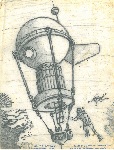 
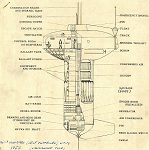
|
